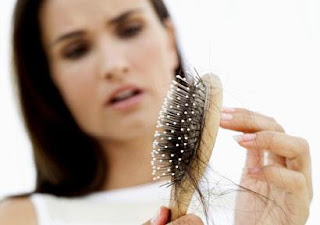HAIR LOSS CAUSES AND SOLUTION
CAUSES OF HAIR LOSS
Baldness is the partial or complete lack of hair growth, and part of the wider topic of "hair thinning"
Alopecia areata (AA) is a condition in which hair is lost from some or all areas of the body, usually from the scalp
Stress is defined as a state of mental or emotional strain or tension resulting from adverse or demanding circumstances.
A normal head of hair contains about 120,000-150,000 strands of hair.
Usually, at any one time, about 90% of those hairs are in a growing phase, growing by about 1/2 inch each month. This phase lasts for two to three years.
At that point, a hair will go into a resting stage. This "rest" lasts for 3 to 4 months before the hair falls out and is replaced by a new one.
"Typically, people shed about 100 hairs a day," says Carolyn Jacob, MD, founder and medical director of Chicago Cosmetic Surgery and Dermatology. "Most people don't even notice."
Sometimes, a significant stress of some sort may spark a change in your body's routine physiological functions, Jacobs says, and cause a disproportionate number of hairs to go into the resting phase at the same time. Then three to four months later, sometimes longer, all those resting hairs are shed. The effect can be alarming. The types of events that disrupt the normal hair cycle, Jacob says, can be caused by the substantial physiological stresses on your body.
Androgenetic alopecia The pattern of hair loss in women differs from male-pattern baldness. In women, the hair becomes thinner all over the head, and the hairline does not recede. Androgenetic alopecia in women rarely leads to total baldness.
Androgenetic alopecia The pattern of hair loss in women differs from male-pattern baldness. In women, the hair becomes thinner all over the head, and the hairline does not recede. Androgenetic alopecia in women rarely leads to total baldness.
Androgenetic alopecia is a common form of hair loss in both men and women. In men, this condition is also known as male-pattern baldness. Hair is lost in a well-defined pattern, beginning above both temples. Over time, the hairline recedes to form a characteristic "M" shape. Hair also thins at the crown (near the top of the head), often progressing to partial or complete baldness.
How to Take Care of Your Hair
1.Wash hair sparingly with a good-quality shampoo. Many people insist that washing hair too often can leave hair dried out, leeched of its natural oils, and damage your hair. Shoot to shampoo your hair at most every other day. Some people wash their hair only twice a week.
2.Don't brush your hair too much. One more surprising habit of people with beautiful hair is their reluctance to use a brush. Many women (and men) prefer only using a natural-fiber comb to detangle hair immediately after showering, and only then taking one pass through.
3.Let hair dry naturally. After you get out of the shower, give your hair a quick pat-down, squeezing the hair gently between the towel. Do NOT rub the hair, this can weaken the follicle and make the hair brittle and dull. Afterwards, give your hair a quick brush-through to get rid of tangles and let your hair dry naturally.
4.Style your hair naturally, minimizing styling damage. Styling by itself won't overly damage your hair, but repeated stylings multiple times per week put some serious strain on hair.
5.Eat healthy and give your hair the right amount of vitamins. Since hair is made of proteins, make sure that you eat a balanced diet rich in lean protein, whole grains, fruits and vegetables. A healthy diet will ensure better-looking, better-feeling hair.
6.Remove stress from your life. Physical and mental stressors will keep your hair from realizing its full potential. Stress can cause hair loss, so try not to let stress overcome you. This means finding healthy emotional outlets for your stress: yoga, biking, meditation, or other forms of exercise all work well.
10 Fruits Beneficial For Treating Hair Loss
Oranges
Orange can be used for hair to promote hair growth and cope with hair loss. You can also use the juice or extract to your hair to get the best results.
Grapefruit
Grapefruit This citrus fruit is a rich source of Vitamin C, an antioxidant that increases blood circulation thus reducing hair loss naturally.
Lemon
Lemon beneficial to give beauty to the hair. You can apply lemon to treat hair loss, dandruff, itchy scalp and dry naturally.
Berries
The dark coloured fruits also help treat hair loss and increase hair growth. It contains natural chemicals called bioflavanoids which increases blood circulation in the scalp thus reducing hair fall naturally.
Cherries
Cherries are rich in bioflavanoids that can help treat hair loss naturally.
Plum
To have healthy hair, you must have plums. You can add the pulp of plums to your hair mask to reduce hair loss.
Banana
Mashed banana pulp if applied on the hair and scalp treats hair loss and helps get shiny and lustrous hair.
Guava
Guava is rich in vitamin A that promotes new hair growth and also increases the function of mucous membranes. Add few drops of honey and lemon juice if you have dandruff. Mix and apply on your hair to get the best results.
Papaya
The juicy extract of papaya is a natural exfoliator for the skin and hair. If mixed with milk and honey, it not only treats scalp problems but also reduces hair fall naturally.
Peaches
This fruit is mostly used to treat scalp problems. If your scalp is not clean, it can lead to hair fall. So, a homemade peach hair mask can be of great help.









No comments:
Post a Comment